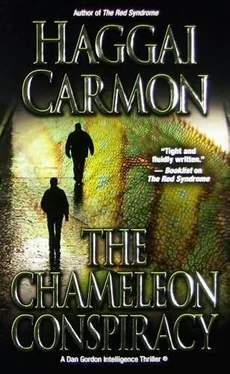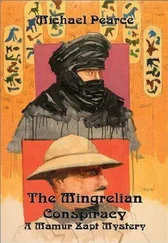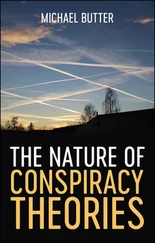Haggai Harmon - The Chameleon Conspiracy
Здесь есть возможность читать онлайн «Haggai Harmon - The Chameleon Conspiracy» весь текст электронной книги совершенно бесплатно (целиком полную версию без сокращений). В некоторых случаях можно слушать аудио, скачать через торрент в формате fb2 и присутствует краткое содержание. Жанр: Триллер, на английском языке. Описание произведения, (предисловие) а так же отзывы посетителей доступны на портале библиотеки ЛибКат.
- Название:The Chameleon Conspiracy
- Автор:
- Жанр:
- Год:неизвестен
- ISBN:нет данных
- Рейтинг книги:5 / 5. Голосов: 1
-
Избранное:Добавить в избранное
- Отзывы:
-
Ваша оценка:
- 100
- 1
- 2
- 3
- 4
- 5
The Chameleon Conspiracy: краткое содержание, описание и аннотация
Предлагаем к чтению аннотацию, описание, краткое содержание или предисловие (зависит от того, что написал сам автор книги «The Chameleon Conspiracy»). Если вы не нашли необходимую информацию о книге — напишите в комментариях, мы постараемся отыскать её.
The Chameleon Conspiracy — читать онлайн бесплатно полную книгу (весь текст) целиком
Ниже представлен текст книги, разбитый по страницам. Система сохранения места последней прочитанной страницы, позволяет с удобством читать онлайн бесплатно книгу «The Chameleon Conspiracy», без необходимости каждый раз заново искать на чём Вы остановились. Поставьте закладку, и сможете в любой момент перейти на страницу, на которой закончили чтение.
Интервал:
Закладка:
“If they graduated at eighteen,” Nicole said, once again as meticulous as possible. “The upper perimeter is too thin. We should assume that some graduated at sixteen or seventeen; therefore their dates of birth could be 1962 or 1963. They would now be in their early forties. We should also look at the possibility that older alumni were used, a few years after their graduation. Let’s put the mark on 1950 as year of birth and 1968 as year of graduation.”
“Fine,” I said. “But bear in mind that we’ve just increased the number of the potential members of the target group.” I got up to open the window shade. “It’s too dark in here.”
“OK, since we’ve got a pool of fifty to one hundred graduates each year and a twelve-year range, that means that we’ve got to identify a group of twelve hundred to twenty-four hundred people,” Nicole said.
“No, only about half, or perhaps a little more,” I said. “The school was coed. I’d suspect that all the perpetrators were males.”
“I suppose we can assume that,” she said. “OK. Then we are left with approximately six to twelve hundred people, possibly all men. How do we identify them? The American School in Tehran no longer exists, but I’m sure there are records somewhere with a list of the students.” Nicole paused for a moment and continued. “We can check that with the Office of Overseas Schools at the State Department. I’ll place an inquiry.”
A day later, Nicole logged into a remote site and downloaded an encrypted file.
“Here it is,” she said. “The complete list of students who attended the school in the years 1960 through 1979. They didn’t have records of students enrolled from 1954, the year the school was started, through 1959. But I think we’ve got more than what we currently need.”
She projected the computer-screen image onto the opposite wall. It was a database sorted alphabetically, with 6,015 records. Each line included the student’s first and last names, name of father or legal guardian, date of birth, sex, Social Security or other national identification number, address, year enrolled, and year left or graduated.
“That’s fantastic,” I said. “We could sort out the Iranian ethnics.”
“How?” Nicole gave me a confused look.
“Iranians don’t usually have American Social Security numbers.”
“Nor would most other non-American students,” she said. “There were many other foreigners in the school, children of non-American expats working for American and European companies such as Westing house, Phillips, or Standard Oil, or at their country’s embassy.”
I wasn’t deterred. “I know that. But the lack of a Social Security number almost certainly flags out a non-American. That’d eliminate many from the list.”
“I agree,” she said. “Although there could be instances where an ethnic Iranian had an SSN because he was born in the U.S., say, or lived in the U.S. while his parents were diplomats or working there, if his parents applied for one.”
“True,” I conceded. “We’ll simply have to work one by one.”
With a few clicks on her laptop computer Nicole isolated all names that didn’t specify an American SSN. From that shorter list, she eliminated all females. “OK,” she said. “We now have 978 names of males who don’t have SSNs listed.”
I quickly looked at the list. Approximately a third had typical European names, as did their fathers. “Let’s get them off the list too, just for now,” I suggested. An hour later we had narrowed down the list to 294 names.
“What do you suggest we do now?” Nicole asked. “We’re done with the easy part. Now how do we isolate from the list ethnic Iranians to be investigated, twenty years after they were recruited, without going to Iran?”
“Then go to Iran,” I said. “Or better yet, ask your people in Iran to help us out. After all, this isn’t guarded military or nuclear information. We’re talking about a bunch of Iranian civilians.”
“Too risky,” said Nicole. “Some of the graduates are now potential suspects under our new theory, but we don’t know which ones. We can make benign-sounding inquiries and hit on some of them. That will immediately trigger the attention of the Iranian security agencies, who’ll wonder why people are asking questions about these men.”
“Even with a perfect legend?” I asked.
“Making inquiries about one suspected individual could be a coincidence, but asking about two or three?”
“I agree that if we limit our inquiries to the suspected group, it will arouse suspicion. But we can broaden the inquiries to include women as well. That might lessen the suspicions.” I paused for a moment and continued. “You’ve just given me an idea. We should have one of the alumni do the inquiries, ideally unwittingly. The end result will be a list of names of the ethnic-Iranian graduates provided by an innocent alumnus or alumna who, even if interrogated, will not be able to show any hidden agenda for the inquiries, just a ‘legitimate’ one. That person can be remotely controlled by your people in Tehran.”
Nicole was quiet for a minute. “I think it’s a good idea, but I’m afraid it can’t be managed by our people in Iran.”
“What does that mean? How can something so simple be beyond the reach of the omnipotent CIA?”
She hesitated. “We’re a little short of assets in Iran these days, as I’m sure you heard during the Giverny conference. It’s all been since the debacle of-” She stopped abruptly.
I raised my head. “What are you talking about?”
“A disaster,” she said.
“Can you tell me what happened?”
“Well, the Iranians know, so I guess there shouldn’t be any reason for you not to know. An officer at Langley mistakenly sent an encrypted secret data flow to one of the Iranian agents in the CIA’s foreign-asset network directly to his high-speed personal communications device. The Iranian who received the download was a double agent. He immediately turned the data over to his handler at VEVAK-the Ministry of Intelligence and Security, the feared security police-and in no time most of our network in Iran collapsed. Several of our Iranian assets were arrested and jailed, and we still don’t know what happened to some of the others. That left us virtually blind in Iran.”
“My god,” I said.
She nodded grimly. “Since then, and until we regroup, Iran is regarded as ‘denied’ territory for us. We’ve got no official station inside Iran and, insofar as human intelligence is concerned, until we redeploy and recruit new assets, we depend on sources outside that country.”
“What about SDLure?” I asked. “I remember hearing from my Mossad buddies, years after I left, about the CIA successfully recruiting top Iranian government officials.”
“Gone with the revolution. The mob discovered their names at the U.S. Embassy. SDLure/1 was Abolhassan Bani-Sadr, the first post-Islamic Revolution president. He fled the country. Another former prime minister, Mehdi Bazargan, was executed. And now this.”
“On the bright side, for now we don’t have to limit our search to Iran. Some of our sources could also be in the U.S.,” I said.
“What do you mean?”
“Well, we’re communicating with alums. The American Overseas Schools in China, Iran, and elsewhere created a special bond and affinity among their students, because they weren’t just places of study, but also cultural and social centers for the children and their families. I’m sure if we interview the American alumni, we can cross-reference everybody in each of the classes. That will do, at least in the beginning.”
“Do they have alumni associations?”
“I found several links. They keep photos, yearbooks, and other material that will make our job less tedious than we think. We’d still need to interview hundreds,” I said, but she had already accepted the task.
Читать дальшеИнтервал:
Закладка:
Похожие книги на «The Chameleon Conspiracy»
Представляем Вашему вниманию похожие книги на «The Chameleon Conspiracy» списком для выбора. Мы отобрали схожую по названию и смыслу литературу в надежде предоставить читателям больше вариантов отыскать новые, интересные, ещё непрочитанные произведения.
Обсуждение, отзывы о книге «The Chameleon Conspiracy» и просто собственные мнения читателей. Оставьте ваши комментарии, напишите, что Вы думаете о произведении, его смысле или главных героях. Укажите что конкретно понравилось, а что нет, и почему Вы так считаете.












